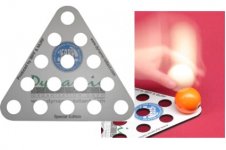Hi!
At our pool hall all the tables have been tapped. Therefore we don't use triangles, and there are no triangle marks. Sometimes the intended break ball is inside the imaginary triangle outline, but not hindering the repositioning of the balls.
How then to interpret the following rule (4.2)?
"The marked outline of the triangle will be used to determine whether an intended break ball is in the rack area."
Reference: http://wpa-pool.com/index.asp?content=rules_tournament
One solution would be to imagine a super-thin triangle and therefore allow these break balls. Another would be to bring out an actual triangle and measure.
What is the correct interpretation?
Any help would be appreciated.
Thanks!
Hermund
At our pool hall all the tables have been tapped. Therefore we don't use triangles, and there are no triangle marks. Sometimes the intended break ball is inside the imaginary triangle outline, but not hindering the repositioning of the balls.
How then to interpret the following rule (4.2)?
"The marked outline of the triangle will be used to determine whether an intended break ball is in the rack area."
Reference: http://wpa-pool.com/index.asp?content=rules_tournament
One solution would be to imagine a super-thin triangle and therefore allow these break balls. Another would be to bring out an actual triangle and measure.
What is the correct interpretation?
Any help would be appreciated.
Thanks!
Hermund
